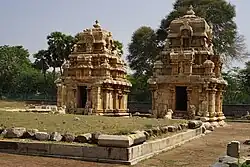Irunkōvēl, also known as Irungkōvēl, Irukkuvēl, and Ilangōvēlir, was a title of the Irunkōvēl line of Velir kings. The Irunkovel line of kings ruled over Konadu identified with the Kodumbalur and surrounding areas in ancient Tamilakkam. They trace their lineage to the clan of Krishna; one of the inscriptions at Kodumbalur belonging to one of the kings in the Irunkovel line, namely Tennavan Irunkōvēl alias Maravan Bhutiyar, declares that he belonged to the kshatriya dynasty which is descended from Yadu (legendary king).[1][2] The Moovar Koil record of Irukkuvel chief Boothi Vikramakesari lauds his father, Samarabirama, as Yadu-vamsa-ketu (Banner of the Yadu race).[1][3]

The contemporary of Karikala
The most famous among them was a contemporary of Karikala Chola as well as poet Kapilar and lived during the Sangam era.[4] Sangam literature mentions a chieftain called Irunkovel who could trace his lineage back over 49 generations to residence in Dvārakā.[5] He is later defeated by Karikala and becomes a subordinate to the Chola sovereign.[6]
Irungola Cholas
The Irungovel chieftains were not merely feudatories but were related to the Cholas through matrimony.[7][8] The Cholas considered the offspring of these unions as one of their own and referred to them as Irungolar meaning child or son in their epigraphs. These princes assumed both the Chola and Irungovel titles like for example there was one Adavallan Gangaikonda Cholan alias Irungolan during the time of Kulottunga I and then there was a certain Sendamangalam Udaiyan Araiyan Edirili Cholan alias Irungolan during the reign of Kulottunga III.[9]
References
Citations
- 1 2 Ayyar, K.R.S.; Government Museum (Chennai, India) (2002). Inscriptions in the Pudukkóttai State. Inscriptions in the Pudukkóttai State. Commissioner of Museums, Government of Tamilnadu. p. 15. Retrieved 20 December 2022.
- ↑ India. Archæological Dept (1913). Epigraphia Indica. [Reports].: New imperial series (in Italian). p. 122. Retrieved 20 December 2022.
- ↑ Indica. Heras Institute of Indian History and Culture, St. Xavier's College. 1995. p. 93. Retrieved 20 December 2022.
- ↑ Historical heritage of the Tamils, page 287
- ↑ Seneviratne, Sudharshan (1994). "The Twilight of Perumaka: South Indian Polity Restructured and Incorporated". In van Bakel, Martin; Hagesteijn, Renee; van de Velde, Pieter (eds.). Pivot Politics: Changing Cultural Identities in Early State Formation Processes. Het Spinhuis. p. 165. ISBN 9789055890071.
- ↑ Studies in Indian epigraphy, Volume 32, page 58
- ↑ Indu Banga; Urban History Association of India; Nehru Memorial Museum and Library (1991). The City in Indian History: Urban Demography, Society, and Politics. South Asia Publications. p. 61. ISBN 978-0-945921-17-2. Retrieved 20 December 2022.
- ↑ Tirumalai, R. (1994). Collected Papers: Studies in South Indian Epigraphy and History of Land Organisation, Development and Accounts and Select Chola, and Pandyan Townships. T.N.D.A. pub. Department of Archaeology, Government of Tamilnadu. p. 177. Retrieved 20 December 2022.
- ↑ Balasubrahmanyam, S.R.; Venkataraman, B.; Ramachandran, B. (1979). Later Chola Temples: Kulottunga I to Rajendra III (A.D. 1070-1280) (in Javanese). Mudgala Trust. p. 80. Retrieved 20 December 2022.
Bibliography
- Historical heritage of the Tamils By Ca. Vē Cuppiramaṇiyan̲, Ka. Ta Tirunāvukkaracu, International Institute of Tamil Studies
- Studies in Indian epigraphy, Volume 32 By Epigraphical Society of India